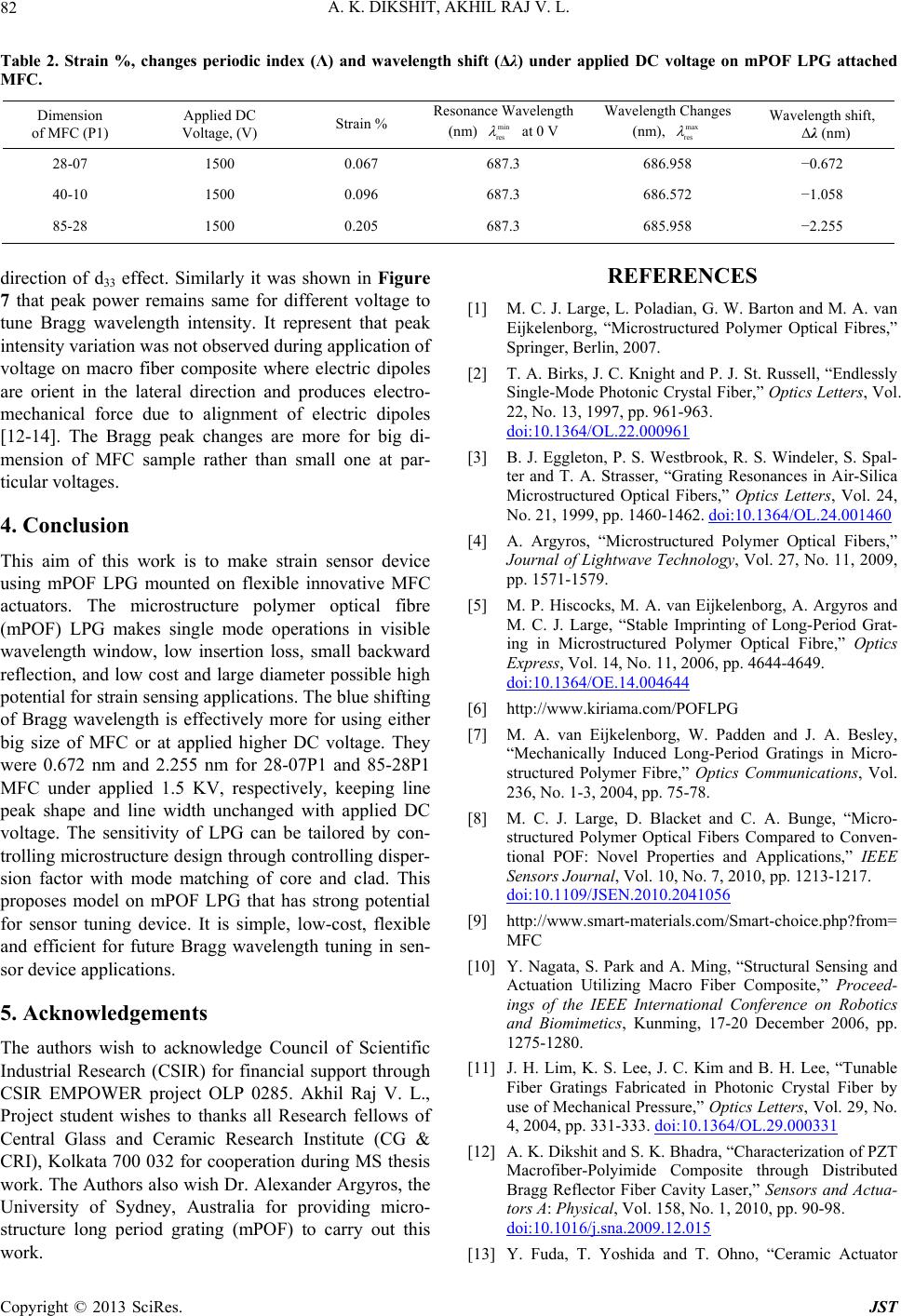
A. K. DIKSHIT, AKHIL RAJ V. L.
82
Table 2. Strain %, changes periodic index (Λ) and wavelength shift (Δλ) under applied DC voltage on mPOF LPG attached
MFC.
Dimension
of MFC (P1)
Applied DC
Voltage, (V) Strain % Resonance Wavelength
(nm) min
res
at 0 V
Wavelength Changes
(nm), max
res
Wavelength shift,
Δλ (nm)
28-07 1500 0.067 687.3 686.958 −0.672
40-10 1500 0.096 687.3 686.572 −1.058
85-28 1500 0.205 687.3 685.958 −2.255
direction of d33 effect. Similarly it was shown in Figure
7 that peak power remains same for different voltage to
tune Bragg wavelength intensity. It represent that peak
intensity variation was not observed during application of
voltage on macro fiber composite where electric dipoles
are orient in the lateral direction and produces electro-
mechanical force due to alignment of electric dipoles
[12-14]. The Bragg peak changes are more for big di-
mension of MFC sample rather than small one at par-
ticular voltages.
4. Conclusion
This aim of this work is to make strain sensor device
using mPOF LPG mounted on flexible innovative MFC
actuators. The microstructure polymer optical fibre
(mPOF) LPG makes single mode operations in visible
wavelength window, low insertion loss, small backward
reflection, and low cost and large diameter possible high
potential for strain sensing applications. The blue shifting
of Bragg wavelength is effectively more for using either
big size of MFC or at applied higher DC voltage. They
were 0.672 nm and 2.255 nm for 28-07P1 and 85-28P1
MFC under applied 1.5 KV, respectively, keeping line
peak shape and line width unchanged with applied DC
voltage. The sensitivity of LPG can be tailored by con-
trolling microstructure design through controlling disper-
sion factor with mode matching of core and clad. This
proposes model on mPOF LPG that has strong potential
for sensor tuning device. It is simple, low-cost, flexible
and efficient for future Bragg wavelength tuning in sen-
sor device applications.
5. Acknowledgements
The authors wish to acknowledge Council of Scientific
Industrial Research (CSIR) for financial support through
CSIR EMPOWER project OLP 0285. Akhil Raj V. L.,
Project student wishes to thanks all Research fellows of
Central Glass and Ceramic Research Institute (CG &
CRI), Kolkata 700 032 for cooperation during MS thesis
work. The Authors also wish Dr. Alexander Argyros, the
University of Sydney, Australia for providing micro-
structure long period grating (mPOF) to carry out this
work.
REFERENCES
[1] M. C. J. Large, L. Poladian, G. W. Barton and M. A. van
Eijkelenborg, “Microstructured Polymer Optical Fibres,”
Springer, Berlin, 2007.
[2] T. A. Birks, J. C. Knight and P. J. St. Russell, “Endlessly
Single-Mode Photonic Crystal Fiber,” Optics Letters, Vol.
22, No. 13, 1997, pp. 961-963.
doi:10.1364/OL.22.000961
[3] B. J. Eggleton, P. S. Westbrook, R. S. Windeler, S. Spal-
ter and T. A. Strasser, “Grating Resonances in Air-Silica
Microstructured Optical Fibers,” Optics Letters, Vol. 24,
No. 21, 1999, pp. 1460-1462. doi:10.1364/OL.24.001460
[4] A. Argyros, “Microstructured Polymer Optical Fibers,”
Journal of Lightwave Technology, Vol. 27, No. 11, 2009,
pp. 1571-1579.
[5] M. P. Hiscocks, M. A. van Eijkelenborg, A. Argyros and
M. C. J. Large, “Stable Imprinting of Long-Period Grat-
ing in Microstructured Polymer Optical Fibre,” Optics
Express, Vol. 14, No. 11, 2006, pp. 4644-4649.
doi:10.1364/OE.14.004644
[6] http://www.kiriama.com/POFLPG
[7] M. A. van Eijkelenborg, W. Padden and J. A. Besley,
“Mechanically Induced Long-Period Gratings in Micro-
structured Polymer Fibre,” Optics Communications, Vol.
236, No. 1-3, 2004, pp. 75-78.
[8] M. C. J. Large, D. Blacket and C. A. Bunge, “Micro-
structured Polymer Optical Fibers Compared to Conven-
tional POF: Novel Properties and Applications,” IEEE
Sensors Journal, Vol. 10, No. 7, 2010, pp. 1213-1217.
doi:10.1109/JSEN.2010.2041056
[9] http://www.smart-materials.com/Smart-choice.php?from=
MFC
[10] Y. Nagata, S. Park and A. Ming, “Structural Sensing and
Actuation Utilizing Macro Fiber Composite,” Proceed-
ings of the IEEE International Conference on Robotics
and Biomimetics, Kunming, 17-20 December 2006, pp.
1275-1280.
[11] J. H. Lim, K. S. Lee, J. C. Kim and B. H. Lee, “Tunable
Fiber Gratings Fabricated in Photonic Crystal Fiber by
use of Mechanical Pressure,” Optics Letters, Vol. 29, No.
4, 2004, pp. 331-333. doi:10.1364/OL.29.000331
[12] A. K. Dikshit and S. K. Bhadra, “Characterization of PZT
Macrofiber-Polyimide Composite through Distributed
Bragg Reflector Fiber Cavity Laser,” Sensors and Actua-
tors A: Physical, Vol. 158, No. 1, 2010, pp. 90-98.
doi:10.1016/j.sna.2009.12.015
[13] Y. Fuda, T. Yoshida and T. Ohno, “Ceramic Actuator
Copyright © 2013 SciRes. JST